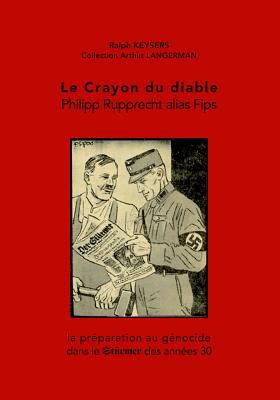Finest Hour 184
Books, Arts, & Curiosities – Incroyable!

July 10, 2019
Finest Hour 184, Second Quarter 2019
Page 46
Review by Antoine Capet
Antoine Capet is Professor Emeritus of British Studies at the University of Rouen and author of Churchill: Le Dictionnaire (2018).
Ralph Keysers, Le Crayon du Diable: Philipp Rupprecht alias Fips: Trois chefs de guerres contre Hitler: W. Churchill, J. Staline et F. Roosevelt dans le Stürmer de 1939 à 1945, S.l.s.n., 2018, 351 pages, €41. ISBN 978–2956076841
First, it is essential to decrypt the title of this book, which collects cartoons savaging the three principal Allied Warlords that were published in the most offensive Nazi weekly Der Stürmer [The Stormer]. The title is not self-explanatory even for a native French speaker. Le Crayon du Diable [the Devil’s pencil] is in fact the name of the series, which also includes three other books. All of these are edited collections with translations and commentaries by Dr. Ralph Keysers, a former Cultural Advisor to the French Embassy in Bonn and Senior University Lecturer in German Studies, now retired. The Devil in question is the cartoonist Philipp Rupprecht, who signed his work as Fips. While Julius Streicher, the founder, owner, and editor of Der Stürmer, was hanged in 1946, Rupprecht got away with a ten-year prison sentence, of which he only served five.
With 130 pages, Winston Churchill “benefits”—if this is the appropriate word—from more coverage than Franklin Roosevelt (115) and Joseph Stalin (88). The reason of course is that until June 1941 Stalin was an ally, and until December 1941 Roosevelt was a neutral, whereas Nazi propaganda unleashed its worst “journalists” on Churchill from September 1939 (in practice, there had been many attacks on Churchill in the German press from 1933). It would of course be tedious to list all the Fips cartoons reproduced in the book. A few selected examples will suffice.
The first one, denouncing Churchill’s return to the Admiralty in September 1939, sets the tone in its caption: “Churchill der Verbrecher” [Churchill the Criminal] showing him on a sailing ship next to a pirate. The drawing is poor, incidentally: Churchill is hardly recognisable—the bow tie being the tell-tale clue. But as the war went on, Fips sometimes improved his rendering of Churchill’s features. Another great theme is introduced in November: Churchill is a puppet of International Jewry. A variant is Churchill shown as the champion of Plutocracy—assimilated to the Jews by the Nazis. Of course, one must remember that Der Stürmer was first and foremost an Anti-Semitic publication, bearing on its masthead: Die Juden sind unser Unglück [the Jews are our misfortune]. In December 1939, a favourite accusation is introduced: Churchill is shown drunk among empty bottles. From 1941, he was shown eagerly drinking blood. Likewise “jokes” of a scatological nature are immediately introduced: Churchill is often depicted on a toilet seat. Additionally, many pictures, even when Churchill is recognisable, have the initials W.C. written on his clothes. The captions speak of Sitzungen—both “sittings” of the British Cabinet and “sittings” on the stool. Another caption plays on the dual meaning of Durchfall— both “diarrhea” and “bungling.” The ultimate in this respect is reached in a May 1940 caption reading “Zweimal Null, das heisst ‘W.C.’” In German hotels, Keysers explains, 00 (double 0—Zweimal Null) was sometimes used on toilet doors. So Churchill, shown before such a door, is both a complete nullity and a water-closet. Many cartoons show a skull in connection with Churchill—often with an allusion to Hamlet. The Jewish nexus leitmotiv runs full circle in a July 1940 cartoon, “The Three Distress Bearers,” in which a cigar-smoking Churchill is dwarfed by an ugly Jew behind him with a half-concealed skull—Death—at the back. Incredibly, these ghastly cartoons seem to have been published as full-colour collector’s cards since many are shown next to the Stürmer pictures. And Keysers tells us that the circulation of Der Stürmer reached a peak of 600,000 weekly in 1940.
From 1941, Churchill is increasingly shown as a puppet of Stalin and then of Roosevelt—sometimes both—with a Jewish banker often lurking behind them. The last two cartoons appeared in February 1945, one showing a diminutive Churchill sheltering behind a tall cowboy (Roosevelt) while a black monster with Chaos written on its breast is hiding in the background. The other, entitled “Democracy in Athens,” shows all the corpses attributed to Churchill’s interference in the Greek civil war. Keysers provides us with his own statistics. Of 196 cartoons showing Churchill in Der Stürmer, ninety-nine show him alone, twenty-nine with Roosevelt, twenty-four with Stalin and Roosevelt, and five with Stalin.
A number of the cartoons in the Stalin section also show Churchill or Churchill and Roosevelt—there is of course an inevitable duplication. But a significant one, entitled “The Sharing of the World,” only shows Stalin and Roosevelt cutting the Earth with a log saw: Churchill (and therefore Britain) are purposely absent. The most glaring absence, however, is that of any cartoons mocking Stalin between September 1939 and June 1941, for obvious reasons.
For his part, Roosevelt is hardly ever shown without a Jewish star on his clothes or a Jewish advisor at his side, and often with the $ sign for good measure. Fips’s attacks began as early as 1939, i.e., before Germany declared war on the United States in December 1941. The “A” in USA is often in the shape of a mason’s square—an attack on Roosevelt as a Freemason. Here again the last cartoons date from February 1945. Comparing the treatment of the three leaders, undiluted hatred for Stalin seems to dominate, whereas for Roosevelt it is contempt. For Churchill the theme is at first a mocking incomprehension of his obstinate refusal to negotiate when all is lost in 1940, followed by repeated accusations of being a war criminal (because of the bombing offensive of the Royal Air Force), and ending once more in mockery towards a dwarf crushed between his two giant masters.
A few of the Fips cartoons are reproduced in the well-known collection compiled by Fred Urquhart in 1955, W.S.C.: A Cartoon Biography, notably the famous “Versoffene Weltanschauung” [Drunken Weltanschauung] of February 1942 showing Churchill’s vision distorted by a bottle of whisky—but the serious collector of Churchill cartoons will no doubt want to have Keysers’s book, though it seems to be self-publishing of a somewhat amateurish nature. The lay-out is poor, with curious blank spaces and footnotes which do not always stand out as such—all this suggests production on a home computer with no professional copy-editing by an established publisher. The reproductions are often too small in size to enable the reader to decipher the German captions below the cartoons even with a magnifying-glass. Still, the work of gathering all these cartoons must have been considerable, and one can only be grateful to the author for it.
Subscribe
WANT MORE?
Get the Churchill Bulletin delivered to your inbox once a month.





